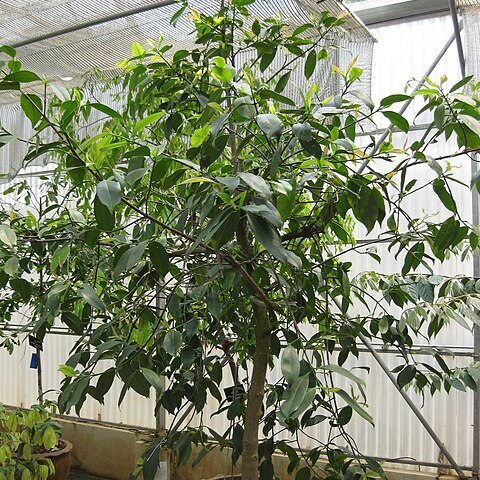Trees 8-12 m tall, 15-20 cm in diam. Bark dark brown. Branches many, borne toward top of trunk, horizontal but usually distally pendulous, slender; twigs dark brown, striate. Petiole 0.8-1.5(-2) cm; leaf blade lanceolate or oblong-lanceolate, 6-14 × 2-5 cm, papery, midvein raised abaxially, impressed adaxially; secondary veins 12-18 pairs, near margin joining together; tertiary veins conspicuous on both surfaces, base cuneate, sometimes slightly decurrent, margin cartilaginous, involute, apex acuminate or long acuminate, rarely acute or obtuse. Plant dioecious. Male flowers 3-8, terminal or axillary, in an umbel; umbel shortly pedunculate or rarely sessile, 4-bracteate at base; bracts subulate; pedicels 4-8 mm, slender; petals yellow, ca. 2 × as long as sepals; stamen fascicles 4, connate, forming a central capitate 4-sided mass of 40-50 anthers; filaments ± absent, at most short, anthers 4-celled, cells longitudinally dehiscent; pistillode absent. Female flowers usually solitary, axillary, larger than male; pedicels robust, 2-3 mm; staminodes united in lower half and enveloping ovary base; filaments long or short, usually shorter than ovary; ovary ovoid, 4-8-loculed; stigma radiately 4-8-lobed, papillate, 6-7 mm high. Mature fruit opaquely yellow-brown, ovoid-globose, oblique, 5-6 × 4-5 cm in diam., 4-8-sulcate, usually apiculate. Seeds 2-4, narrow, fusiform, slightly curved, ca. 2.5 cm, rough. Fl. May, fr. Jul-Oct. 2n = 52.
More
A tree. It grows 8-12 m tall. The trunk can be 30-50 cm across. The trunk is straight but usually with many knots. The crown is oval and the leaves are dark green. The small branches are often 4 sided. The leaves are narrowly sword shaped and 7-12 cm long by 3-5 cm wide. The flowers are yellow and 1 cm across. Male and female flowers are separate. The fruit is rounded with 4-8 segments. It is 3-4 cm across. There are 6-10 seeds with a layer around them.


